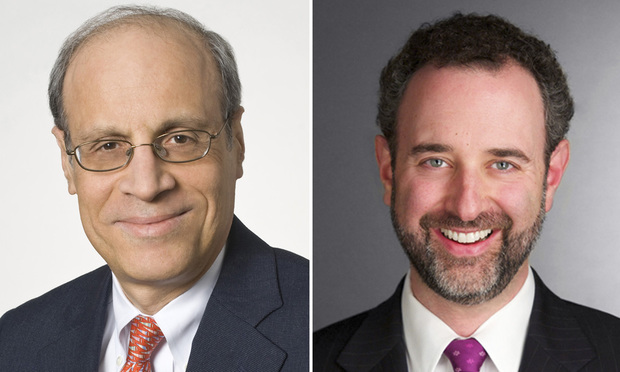Judicial Review of Certain PTAB Decisions Following 'Thryv v. Click-to-Call'
In their Intellectual Property Litigation column, Lewis Clayton and Eric Alan Stone discuss the issue of federal courts reviewing PTAB decisions on the timeliness of a petition for inter partes review.
July 14, 2020 at 12:15 PM
10 minute read
 Lewis R. Clayton and Eric Alan Stone
Lewis R. Clayton and Eric Alan Stone
In creating inter partes review and post grant review as part of the America Invents Act, Congress vested in the Patent Office the power to decide whether to institute such a review when requested by a challenger. The availability and scope of judicial review of those institution decisions has attracted significant attention in the federal courts.
Earlier this term, the Supreme Court held that federal courts cannot review the Patent Trial and Appeal Board's decision regarding the timeliness of a petition for inter partes review. See Thryv, v. Click-to-Call Techs., 140 S. Ct. 1367 (2020). Thryv left open several related questions, however, and since Thryv the Federal Circuit has issued one decision—with two more pending—regarding the availability of judicial review of other aspects of PTAB institution decisions. See ESIP Series 2 v. Puzhen Life USA, 958 F.3d 1378 (Fed. Cir. 2020); Facebook v. Windy City Innovations, 953 F.3d 1313 (2020); SIPCO v. Emerson Elec. Co., 939 F.3d 1301 (Fed. Cir. 2019), vacated, No. 19-966, 2020 WL 3146672 (2020). We report here on these cases.
Cuozzo and the "No Appeal" Provisions of Sections 314(d) and 324(e)
Section 314 of Title 35 governs the institution of inter partes review (IPR) proceedings. Section 314(d), entitled "No Appeal," states "[t]he determination by the Director whether to institute an inter partes review under this section shall be final and nonappealable." Likewise, Section 324, which governs institution of covered business method review (CBM), also contains a "No Appeal" provision that states "[t]he determination by the Director whether to institute a post-grant review under this section shall be final and nonappealable." 35 U.S.C. §324(e).
Four years ago, in Cuozzo Speed Technologies v. Lee, the Supreme Court addressed when, if ever, the decision to institute an IPR can be challenged on appeal. The court held that Section 314(d) precludes review of the Patent Office's institution decisions where "the grounds for attacking the decision to institute inter partes review consist of questions that are closely tied to the application and interpretation of statutes related to the Patent Office's decision to initiate inter partes review." 136 S. Ct. 2131, 2141 (2016). The Cuozzo court noted, however, that it was not deciding the "the precise effect of §314(d) on appeals that implicate constitutional questions, that depend on other less closely related statutes, or that present other questions of interpretation that reach, in terms of scope and impact, well beyond 'this section.'" Id. For example, IPR challenges must be based on printed prior art, rather than on an asserted failure to meet the requirements of Section 112; the court noted that its decision does not "enable the agency to act outside its statutory limits by, for example, canceling a patent claim for 'indefiniteness under §112' in inter partes review." Id. at 2141–42. The court allowed that such "'shenanigans' may be properly reviewable in the context of" 35 U.S.C. §319 and under the Administrative Procedure Act. Id. at 2142.
'Thryv v. Click-to-Call'
The Thryv case addressed whether the Patent Office's decision that an IPR challenge was timely could be reviewed on appeal, or whether Section 314(d) precluded judicial review of the Patent Office's timeliness determination.
Thryv's predecessors were sued in 2001 for infringement of Click-to-Call's patent relating to technology for anonymous telephone calls, and the suit was later voluntarily dismissed without prejudice. Thryv, 140 S.Ct. at 1371. In 2013, Thryv petitioned for IPR of Click-to-Call's patent. Because 35 U.S.C. §315(b) precludes an entity from filing an IPR petition more than one year after it was (or those in privity with it were) "served with a complaint alleging infringement of the patent," Click-to-Call argued that the prior lawsuit against Thryv's predecessors rendered Thryv's IPR untimely. The PTAB rejected Click-to-Call's argument and instituted review, holding that "a complaint dismissed without prejudice does not trigger §315(b)'s one-year limit." Id. On the merits, the PTAB invalidated 13 of Click-to-Call's patent claims as obvious or anticipated.
Click-to-Call appealed the PTAB's time-bar decision. The Federal Circuit dismissed for lack of jurisdiction, agreeing with Thryv and the Patent Office that Section 314(d) precluded judicial review of the PTAB's timeliness decision. Id. at 1371–72. Following its en banc decision in Wi-Fi One v. Broadcom Corp., 878 F.3d 1364 (Fed. Cir. 2018), however, the Federal Circuit granted panel rehearing and reversed its previous decision, holding that Thryv's petition for IPR was untimely "because the 2001 infringement complaint, though dismissed without prejudice, started the one-year clock under §315(b)," 140 S.Ct. at 1372.
The Supreme Court granted certiorari and vacated the Federal Circuit's decision, holding that the PTAB's decision that Thryv's petition was timely under Section 315(b)'s "time limit" is "closely related to its decision whether to institute inter partes review and is therefore rendered nonappealable by §314(d)." Id. at 1370. The court explained that because the one-year bar in Section 315(b) "expressly governs institution and nothing more," a contention that a petition is untimely under that provision "is a contention that the agency should have refused 'to institute an inter partes review.'" A challenge to a petition's timeliness thus raises 'an ordinary dispute about the application of an institution-related statute'" under Cuozzo. Id. at 1373 (citations omitted).
'ESIP Series 2 v. Puzhen Life'
In ESIP, the Federal Circuit applied Thryv and Cuozzo to address the appellate review of the PTAB's decision regarding whether a petition properly identified the real parties in interest. Puzhen Life petitioned for IPR of an ESIP patent relating to air diffusers. 958 F.3d at 1380. In defending against that challenge, ESIP argued before the PTAB that Puzhen had failed to identify two real parties in interest as required by 35 U.S.C. §312(a)(2), which states that "a petition may be considered only if" it includes "identification of all real parties in interest." Id. at 1385–86. The PTAB rejected that challenge, and invalidated the claims of ESIP's patent as obvious. ESIP appealed, attacking both the obviousness determination and the PTAB's conclusion that Puzhen had properly identified the real parties in interest.
The Federal Circuit rejected the real-parties-in-interest challenge as outside the federal courts' review: "In view of Cuozzo and [Thryv], we find no principled reason why preclusion of judicial review under §314(d) would not extend to a Board decision concerning the 'real parties in interest' requirement of §312(a)(2). ESIP's contention that the Board failed to comply with §312(a)(2) is 'a contention that the agency should have refused to institute an inter partes review.'" Id. at 1386. A real-parties-in-interest determination is "'an ordinary dispute about the application of' an institution-related statute," and is thus unreviewable. Id.
'Facebook v. Windy City Innovations'
Windy City sued Facebook for infringing patents related to methods of communicating over a computer-based network. Facebook, 953 F.3d at 1317. Exactly one year after being served with Windy City's complaint, and before Windy City had identified the specific claims it was asserting in district court, Facebook petitioned for IPR of several claims of each patent. After Windy City identified its asserted claims—and also after the one-year time bar of §315(b) passed—Facebook filed two more petitions for IPR of additional claims of two of Windy City's patents, and moved for joinder of the new IPRs to the already instituted IPRs. The PTAB instituted both new IPRs and granted Facebook's motions for joinder, finding that Facebook "has established good cause for joining" the new proceedings with the existing IPRs. Id. at 1317, 1320. When the PTAB issued its final written decisions, some of the claims it found unpatentable were claims challenged only in the later-filed IPRs. Id. at 1317–18. Windy City appealed the PTAB's joinder decisions and obviousness findings. Id. at 1318.
The Federal Circuit issued a decision before Thryv came down, and agreed with Windy City that "§315(c) does not authorize same-party joinder and also that it does not authorize joinder of new issues material to patentability, such as new claims or new grounds." Id at 1322. The court held that the statute allows the Patent Office "to 'join as a party to [an IPR] any person who' meets certain threshold requirements," and that it would be "an extraordinary usage of the term 'join as a party' to refer to persons who were already parties." Id. at 1324.
After Thryv came down, Facebook petitioned for rehearing and the Federal Circuit invited briefing from the parties and the United States. 803 F. App'x 408. In its supplemental brief, Facebook argues that disputes about whether joinder was proper are a type of dispute about whether "the petitions were untimely and should not have been instituted—and Thryv makes clear that Section 314(d) bars review of that claim." 2020 WL 3169492, at *1. Windy City responds that improper joinder of two IPRs is "an agency action outside the scope of its authority," and is thus "precisely the type of issue that is judicially reviewable, even after Thryv." 2020 WL 3169493, at *2. The United States, as amicus curiae, agrees with Facebook that joinder decisions are integral to institution decisions and are thus not reviewable on appeal, "[a]t least where the Board institutes an inter partes review on a petition that would otherwise be untimely.'" 2020 WL 3169491, at *6. The case remains pending.
'SIPCO v. Emerson Electric'
Emerson Electric petitioned for CBM review of a SIPCO patent related to a communication device. SIPCO, 939 F.3d at 1304. In deciding to institute CBM review, the PTAB concluded SIPCO's patent did not claim a "technological invention" and qualified as a "covered business method patent" within the meaning of the America Invents Act. Id. at 1305.
In its final written decision the PTAB reiterated its "technological invention" analysis and also found the challenged claims patent-ineligible and obvious. SIPCO appealed. Id. at 1306–07. On appeal, while Thryv was still pending, the Federal Circuit held that some of the PTAB's findings regarding whether the patent covered a "technological invention" were arbitrary and capricious, vacated the Board's patentability determinations, and remanded to the Board to reconsider whether the patent claimed a technological invention. Id. at 1311, 1314.
Emerson petitioned for certiorari, arguing that the then-pending Thryv case might shed light on whether a court may review the PTAB's decision that a patent meets the threshold requirements for CBM. 2020 WL 550758, at *I. On June 15, the Supreme Court granted Emerson's petition, vacated the Federal Circuit's decision, and remanded the case to the Federal Circuit "for further consideration in light of" Thryv. 2020 WL 3146672, at *1. The case now remains pending at the Federal Circuit.
Lewis R. Clayton and Eric Alan Stone are litigation partners at Paul, Weiss, Rifkind, Wharton & Garrison.
This content has been archived. It is available through our partners, LexisNexis® and Bloomberg Law.
To view this content, please continue to their sites.
Not a Lexis Subscriber?
Subscribe Now
Not a Bloomberg Law Subscriber?
Subscribe Now
NOT FOR REPRINT
© 2025 ALM Global, LLC, All Rights Reserved. Request academic re-use from www.copyright.com. All other uses, submit a request to [email protected]. For more information visit Asset & Logo Licensing.
You Might Like
View All
Orrick Hires Longtime Weil Partner as New Head of Antitrust Litigation

Profits Surge Across Big Law Tiers, but Am Law 50 Segmentation Accelerates
4 minute readLaw Firms Mentioned
Trending Stories
- 1Trump's DOJ Files Lawsuit Seeking to Block $14B Tech Merger
- 2'No Retributive Actions,' Kash Patel Pledges if Confirmed to FBI
- 3Justice Department Sues to Block $14 Billion Juniper Buyout by Hewlett Packard Enterprise
- 4A Texas Lawyer Just Rose to the Trump Administration
- 5Hogan Lovells Hires White & Case Corporate and Finance Team in Italy
Who Got The Work
J. Brugh Lower of Gibbons has entered an appearance for industrial equipment supplier Devco Corporation in a pending trademark infringement lawsuit. The suit, accusing the defendant of selling knock-off Graco products, was filed Dec. 18 in New Jersey District Court by Rivkin Radler on behalf of Graco Inc. and Graco Minnesota. The case, assigned to U.S. District Judge Zahid N. Quraishi, is 3:24-cv-11294, Graco Inc. et al v. Devco Corporation.
Who Got The Work
Rebecca Maller-Stein and Kent A. Yalowitz of Arnold & Porter Kaye Scholer have entered their appearances for Hanaco Venture Capital and its executives, Lior Prosor and David Frankel, in a pending securities lawsuit. The action, filed on Dec. 24 in New York Southern District Court by Zell, Aron & Co. on behalf of Goldeneye Advisors, accuses the defendants of negligently and fraudulently managing the plaintiff's $1 million investment. The case, assigned to U.S. District Judge Vernon S. Broderick, is 1:24-cv-09918, Goldeneye Advisors, LLC v. Hanaco Venture Capital, Ltd. et al.
Who Got The Work
Attorneys from A&O Shearman has stepped in as defense counsel for Toronto-Dominion Bank and other defendants in a pending securities class action. The suit, filed Dec. 11 in New York Southern District Court by Bleichmar Fonti & Auld, accuses the defendants of concealing the bank's 'pervasive' deficiencies in regards to its compliance with the Bank Secrecy Act and the quality of its anti-money laundering controls. The case, assigned to U.S. District Judge Arun Subramanian, is 1:24-cv-09445, Gonzalez v. The Toronto-Dominion Bank et al.
Who Got The Work
Crown Castle International, a Pennsylvania company providing shared communications infrastructure, has turned to Luke D. Wolf of Gordon Rees Scully Mansukhani to fend off a pending breach-of-contract lawsuit. The court action, filed Nov. 25 in Michigan Eastern District Court by Hooper Hathaway PC on behalf of The Town Residences LLC, accuses Crown Castle of failing to transfer approximately $30,000 in utility payments from T-Mobile in breach of a roof-top lease and assignment agreement. The case, assigned to U.S. District Judge Susan K. Declercq, is 2:24-cv-13131, The Town Residences LLC v. T-Mobile US, Inc. et al.
Who Got The Work
Wilfred P. Coronato and Daniel M. Schwartz of McCarter & English have stepped in as defense counsel to Electrolux Home Products Inc. in a pending product liability lawsuit. The court action, filed Nov. 26 in New York Eastern District Court by Poulos Lopiccolo PC and Nagel Rice LLP on behalf of David Stern, alleges that the defendant's refrigerators’ drawers and shelving repeatedly break and fall apart within months after purchase. The case, assigned to U.S. District Judge Joan M. Azrack, is 2:24-cv-08204, Stern v. Electrolux Home Products, Inc.
Featured Firms
Law Offices of Gary Martin Hays & Associates, P.C.
(470) 294-1674
Law Offices of Mark E. Salomone
(857) 444-6468
Smith & Hassler
(713) 739-1250








